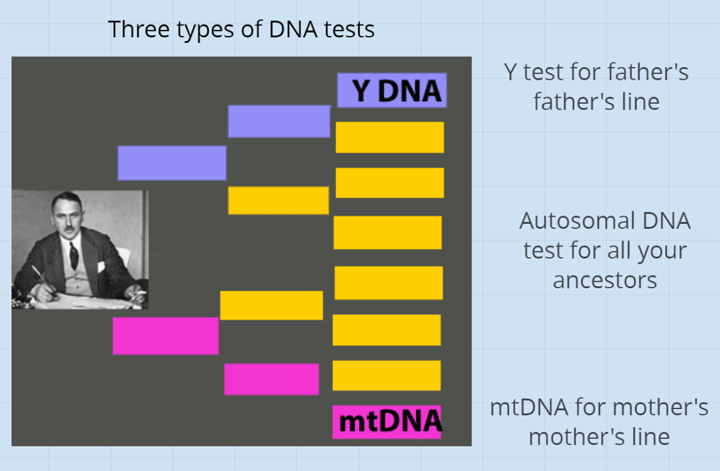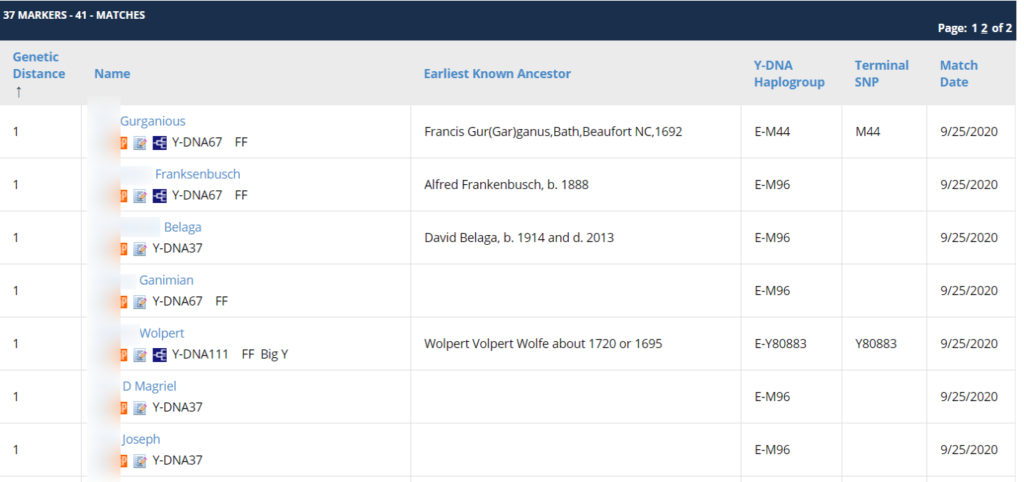Sometimes testing the Y chromosome can help when you are looking for a missing father, grandfather, or further back as long as you have a tester descended on the male only line. Remember the Y is passed father to son, so any changes are rare and are caused by mutations not recombination. Typically a man would start with a Y 37 STR marker test at Family Tree DNA to see if this avenue is worth pursuing. A STR test gets the most recent changes rather than the haplogroup, thus can suggest a surname. Click here for my article explaining Y testing.

Slide from my 2017 talk on DNA testing for genealogists featuring my maternal grandad
The Y results will not help if no other men from that Y lineage have tested unless you have a theory. In that case you need to test someone else descended on the male only line from the presumed ancestor.
Y testing can be very useful when the unknown parentage occured many generations ago, such that autosomal testing may not be able to solve it.
If your ancestors have been in the USA for some time then a Y 37 STR marker test may find a probable last name. In that case there may be a surname project with other Y testers at Family Tree DNA. I recommend contacting the admins of that project as they can often be a great help in your quest. However if you are from a population group which has only had inherited surnames for two hundred years or less, quite likely you will have no luck.
Here is an example from the Y test of a Jewish man with Polish Galician roots, surnames only happened there in about 1815.
As you can see, not a single surname is in common despite all being one step matches. Family Tree DNA has a nice chart in their help center to give you a feel for what a genetic distance number means (click here). For surname research, I have found that a distance in the range 0-3 on a 37 marker test is the desired target. Warning, that number cannot be tied to a specific number of years. My second cousin has a 0 step match to a cousin sharing an ancestor born in the 1600s while my Dad has a 3 step match to a cousin sharing an ancestor born around the same time. I also know of a case where a son has a 2 step match to his father, a relationship proven in the autosomal DNA.
In my own family, my DNA research started by trying to find the ancestors of my Norwegian 4th grandfather. There were ten men with his name, Lars Monsen, born in the Bergen area in the right time frame; our hope was that a Y test would help figure this out. Unfortunately there were no close Y matches, so we needed to test another man descended from his possible grandfather. Click here to read that story.
Recently I was working on a case of an unknown father of an unknown father. Barry had figured out who his unknown father was, call him Lionel, but Lionel’s father was also unknown. Autosomal DNA pointed to a Smith family in Pearl River, Mississippi. However when Barry did a Y DNA test his closest matches had the surname Gilliland!
So we joined him to the Gilliland project where we found a number of Smiths, one of whom was a good autosomal match, although a 2 step Y match. Correspondence with him confirmed that some unknown Gilliland fathered this Smith line back during the American Revolution and yes, some of those descendants ended up in Pearl River!
On the other hand, in a number of cases that have been mainly solved with autosomal DNA, the Y STR test has confirmed the expected surname. If you have a male line descendant, it is always worth trying a Y test when working with unknown parentage, but you may find extra surprises like Barry did!
My Dad would be 101 today and I thank him again for doing every DNA test I asked for, including his Y to solve our own family mystery.


A couple of years ago I had an unexpected match show up at FTDNA as an exact 67 marker match with my yDNA. The match was an adoptee who did not know who his parents might be. He was also a close yDNA match with other known North Carolina Dowells. After much research we were able to confirm that he was indeed the son of a North Carolina Dowell and was in fact my 6th cousin-once removed. This confirmation was made when two other Dowell descendants subsequently tested and were shown to be 1st cousins of the adoptee. The yDNA match, birth location and date led to those two 1st cousins who were willing to test.
Thank you for sharing that Dave. Another way testing Y can be a win for an adoptee. He got lucky matching an expert genetic genealogist like you
Everyone should dip their toe in this pond. It’s fun for starters!
I think the number of markers needed very much depends on how frequently the haplogroup appears in the community generally and testers in particular.
Your Gilliland example had the advantage of an exceedingly rare surname for R1b-M269. But your typical Scottish Smith or Black or MacWhatever can be a different proposition.
Those of Scots and Irish descent typically have R1b at around 70%+ and 80%+ respectively. They need more detail to tell them apart, and if it is not a rare name, it is more markers. 67 markers used to be standard for this, but lately, friends from these R1b-rich regions who have tried 67 or 111 recommend 111 as a starting point.
I am at the other end of things being T, and a rareish subbranch of that.
If I find someone with my surname from the same region in the homeland, I may need as few as 12 markers to show a very strong likelihood of a close match. Good enough to invest in a couple of SNPs or Y700 to make sure.
One thing 37 markers can be really good for is introducing people to genetic genealogy. While they are handling the first results and grasping the fundamentals they begin to take charge of where their research resources are placed.
It’s what I started with, but that was back in the noughties.
I wonder why Y and Mt DNA are not used as much in genealogy search. Given that they are such an integral part of any person’s heritage and DNA, there ought to be an algorithm that takes both Y and Mt information along with autosomal composition.
Charles –
The reason Y and mtDNA are not used more is that they often reach back before genealogical records. An mtDNA match can be related to you 5000 years ago. Y DNA, on the other hand, can be useful in some cases as descibed in this post.
Autosomal DNA is far more useful for recent ancestry. Combining it in a computer algorithm does not make sense since they work in different time frames. You can always use Y or mtDNA to exclude certain genealogical pathways when combined with autosomal.
I used y-DNA37 to prove the likelihood of my male line which matched at 100%. However, Got some surprises at the 67 marker level and ended up with a single and unexpected surname at 111 markers. The system works.
As a point of interest, mtDNA testing has proven valuable in following my maternal line. Autosomal testing at 3 companies has also proven both lines and provided numerous relatives which are confirmed by paper research. All tests taken so far have been worth the cost and effort.
Pingback: Friday’s Family History Finds | Empty Branches on the Family Tree
I would like your opinion on which test to do next. I’m a volunteer helping a young guy find his birth father. I have worked with his AncestryDNA for quite a while and have identified, I think, 2 of his paternal grandparents and 2 of their daughters. The daughters have sons but won’t give us their names. I think one of the sons is the birth father and he has some distant DNA matches with trees to work with. My question is: should he do a Y-DNA37 test next or a 23andMe.com test? His money is very tight and I’m going to send him the test.
Have you uploaded his ancestry DNA results to GEDmatch, familytree dna, and MyHeritage? Ancestry has by far the biggest database but sometimes a match elsewhere can be the break through. A Y37 test might give you a surname but the 23andme is more likely to be helpful if another good match is there. Since you have one set of paternal grandparents you are looking for the others via matches to one of the husband lines for those daughters. Are there other children of those grandparents? Have you used WATO with the more distant matches?
Thank you Kitty for those good ideas! He has not uploaded to GEDmatch yet, but I did ask, but I’ll ask again. (I don’t think I can do it for him?) I think you now have to pay for the other two, so I didn’t ask him yet. He has a 848cM match to one daughter of the 2 paternal grandparents, and she has 2 sisters and one brother. I checked all the spouses of her siblings for matches on their lines, but there were none. One close relative hinted that one of the other sisters had a son or sons with someone she wasn’t married to, so that is my problem. Plus the fact that they are all very young, so no obits, census records, etc. Maybe I should join BeenVerified to look for their sons? I think you are right about going with 23andMe next, because even if I get a surname thru a Y-DNA test I won’t find the right guy. I have not used WATO, but I did put the matches family lines on his public tree and see the ThruLines, which gives the probability. Thanks again!
Well 848 could certainly be a great aunt which would be the relationship if the son of her sister is the dad you are looking for. Then those are paternal great grandparents.
Yes I use been verified often in these cases.
Thanks Kitty for pointing out that they could be great grandparents, not grandparents like I thought! And also the tip about BeenVerified, I’ll try that. You have once again been such a great help in helping to solve these unknown parentage cases!
I just checked again and FamilyTreeDNA is free for a transfer but on MyHeritageDNA you have to buy a new kit for $33. So I ask him to upload the two free ones. Thanks!